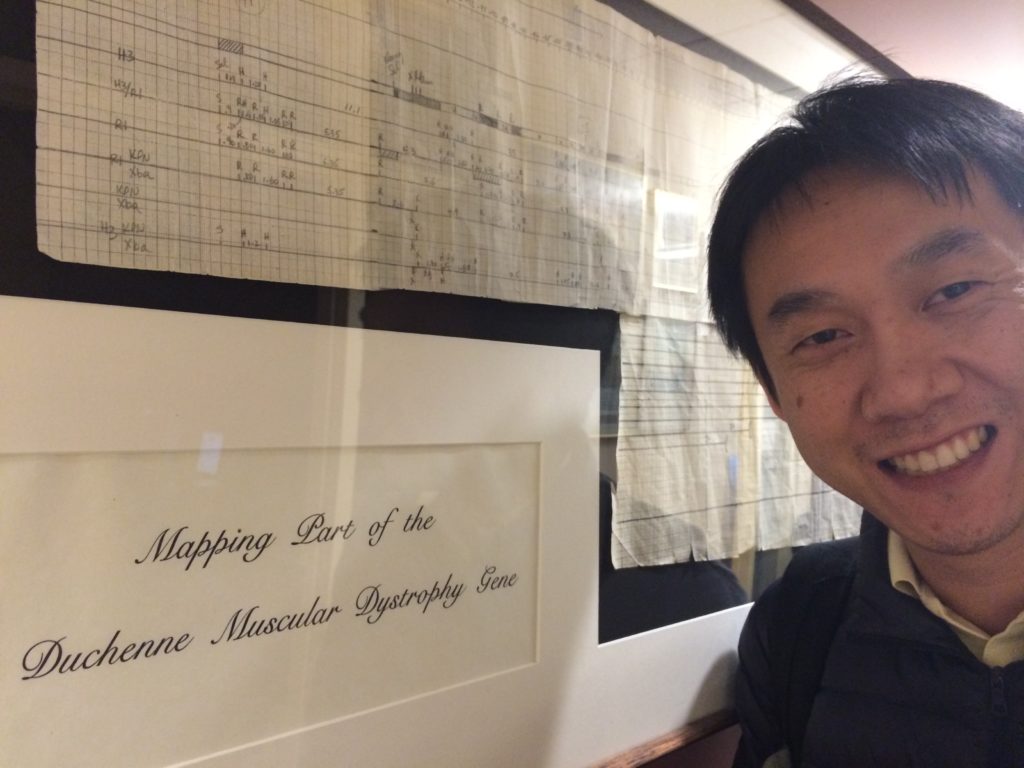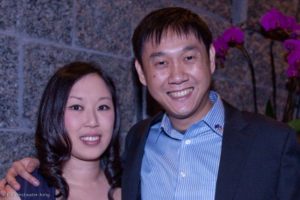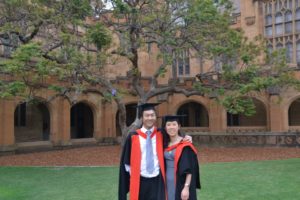
In 2004, Monkol Lek was at a crossroads.
As a 24-year-old living in his native Australia and working as a security professional at IBM, Monkol found himself increasingly affected by the symptoms of a then-undiagnosed subtype of limb-girdle muscular dystrophy (LGMD). The frustration of not having a confirmed genetic diagnosis and the lack of answers provided by his neurologist at every six month check-up motivated him to re-evaluate his career trajectory.
“My degree was in computer engineering,” Monkol says. “I thought, here I am working so hard, but work wasn’t making me happy. I kept thinking about my disease and wanting to know why I didn’t have a genetic diagnosis, and why it was so hard to find the gene. How would my disease progress? And how could I help in this process?”
Determined to find these answers, Monkol left his job at IBM, re-enrolled at his alma mater, the University of New South Wales (UNSW), and continued his education, shifting gears to learn the science behind his disease.
Thirteen years later, equipped with two additional bachelor’s degrees and a Ph.D., Monkol, now 38, is a promising muscle disease researcher at the Broad Institute of MIT and Harvard, located in Cambridge, Mass. In December 2017, he will be moving to New Haven, Conn., to establish his own lab at the Yale School of Medicine, teaching and training the next generation of scientists.
Although Monkol finally has a genetic diagnosis — LGMD type 2G — he remembers what it feels like to be undiagnosed with only a vague understanding of his disease. This experience has motivated him to dedicate his career to help others searching for a definitive diagnosis.

Early Years
In 1981, the Lek family fled Cambodia’s civil war and settled in Australia as refugees. The youngest of seven children, Monkol and his family moved to the working-class suburbs of Sydney, where he grew up. Throughout his childhood, he was asymptomatic until age 19, when he first started to notice muscle fatigue in his legs.
“I was going to UNSW at the time and was having a hard time going up stairs at the train station,” Monkol says. “I was standing for long periods of time and had to take the bus an hour-and-a-half each day. I would come home tired and exhausted, and the muscles in my legs really ached.”
Concerned, Monkol went to a few different doctors who didn’t think much of his condition, until one doctor decided to take a blood test. “This one doctor took a blood test, looked at my creatine kinase levels, saw that they were really high and asked if I ran a marathon,” Monkol recalls. “He said something was really wrong with me and suggested I go see a neurologist.”
Two years later, a neurologist diagnosed Monkol with a form of LGMD, although the exact type was unknown. Even after a muscle biopsy in his thigh, they could not pinpoint exactly what type of LGMD he had. He had a clinical diagnosis but not a genetic one.
His symptoms were consistent with one of his older sisters, 10 years his senior. “I never thought that I might have her disease too, mainly because I didn’t have a genetics background,” Monkol says. “It’s not something I thought about. In retrospect, it should have just clicked.”
In addition to not knowing what type of muscle disease he and his sister had, Monkol grew increasingly frustrated with the lack of meaningful information provided at his checkups. “I went to see a neurologist every six months,” says Monkol, “and the doctor would do the same things each time — muscle strength tests and things like that. I was frustrated every time. They’d take notes, talk about how my disease was progressing and at the end tell me I’m getting weaker, and that was it.”
At a Crossroads
This frustration went on for several years. Although Monkol enjoyed working at IBM, he decided to dedicate his career to finding answers to his questions. In 2004, at age 24, he re-enrolled at UNSW, intent on building the skills necessary to understand the genetic underpinning of his disease.
He went back to school and graduated with degrees in bioinformatics and physiology from UNSW. After, he decided to continue his education, enrolling in a Ph.D. program in medicine at the University of Sydney to research the genetics of muscle strength and performance. His choice of school was deliberate. The University of Sydney’s diagnostics lab happened to be looking for the very gene that caused his disease. “You want researchers to think a lot about your disease, not every six months,” says Monkol. “I figured, why not do my Ph.D. there?”
In the final year of his program, Monkol received the news he had been waiting for. “They found my disease-causing gene,” he remembers. “It was called TCAP.” Although Monkol was excited to finally have a genetic diagnosis of his LGMD subtype, he knew there were many people throughout the world who were still struggling to find a diagnosis for their own conditions. He wanted to be the one to help provide those answers.
Moving to the USA
After graduating with his Ph.D., Monkol was interested in continuing his collaboration with Daniel MacArthur, his colleague and mentor at the University of Sydney. Daniel had recently moved to the United States to establish a rare genetic diseases lab at the Broad Institute of MIT and Harvard, a research institution in Cambridge, Mass. The Broad Institute is affiliated with five Harvard teaching hospitals, including Brigham and Women’s Hospital (site of an MDA Care Center) and Massachusetts General Hospital (site of an MDA Care Center and MDA ALS Care Center).

While in Cambridge to interview, Monkol was struck by a museum exhibit in the lobby of the Broad Institute building. “In the lobby was a machine — a museum piece — a next-generation sequencer, used to sequence human DNA. It was the best sequencer that we had in Sydney, and here they were using it as a museum piece! I knew I had to come here.”
Soon after, Monkol made the decision to join the MacArthur Lab and moved to the United States with his wife, Angela, also a muscle disease researcher. As Monkol began his work, Angela found a position with Dr. Louis Kunkel at his lab at Boston Children’s Hospital (also the site of an MDA Care Center). Kunkel — a longtime MDA-funded researcher — helped discover the dystrophin gene 30 years ago.
Angela’s support and caregiving have been essential in allowing Monkol to move to a new country and thrive in his research. “Angela is not just a talented scientist; she also has made a lot of sacrifices to support me in many daily things that I struggle with,” he says.
Finding Answers for Others
Although living halfway around the world from where he grew up, Monkol remained as motivated as ever to work on research near to his heart — helping individuals attain a definitive diagnosis.
To do this, Monkol and team use cutting-edge technology to perform exome sequencing — in short, sequencing genes simultaneously to find rare variants that cause disease.
Over the last four years, the lab’s success rate has hovered around 50 percent in diagnosing the genetic cause of individuals’ diseases, providing answers to many families around the world from as far away as Azerbaijan and Russia. For many individuals and families, the lab’s work has helped to give them peace of mind and hope.
A New Chapter
The last few years in MacArthur’s lab at the Broad Institute have been tremendously gratifying for Monkol, validating his decision so many years ago to enter the scientific field. He realizes how lucky he is to be in this position. “If we stayed in Cambodia, I could have been a farm boy looking for answers for my muscle weakness. ”
Although Monkol is proud of his work, he wants to help all undiagnosed individuals, including those who couldn’t get an answer from his exome sequencing research.

As a result, starting in December, Monkol will be establishing his very own lab at Yale University. One of the lab’s main goals is to continue his work in exome and genome sequencing to find disease-causing mutations in hard-to-diagnose cases. Of special focus are patients in underserved populations, such as in East Asia, whose mutations and incidence rates are not as well-known in the general literature as those of Europeans.
Much of the research that Monkol has worked on in his career has been funded and supported by MDA. “I want to thank MDA for their generous support with my MDA/AANEM Development Grant for a project aimed at improving the diagnosis of rare muscle diseases, which has supported my transition to becoming an independent investigator,” he says.
Because his lab is brand new, Monkol is actively recruiting postdoctoral fellows and graduate students. In addition to the job’s technical aspects, Monkol has a particular type of scientist he wants to work alongside.
“I want researchers who have the same passion as me, who don’t see it as just a 9 to 5 job. I want researchers who work all week for a particular result, that when they get it, they get so excited that they lose track of time,” he says.
“They are the people I want to work with and who also inspire me.”
